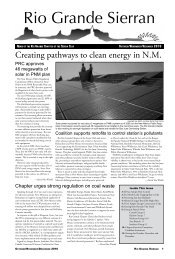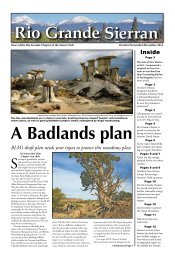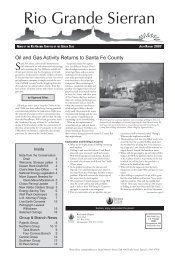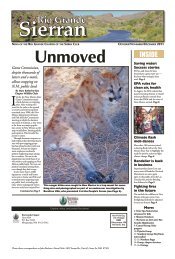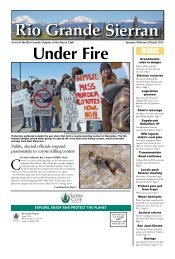Choosing pollution Your photo - Rio Grande Chapter
Choosing pollution Your photo - Rio Grande Chapter
Choosing pollution Your photo - Rio Grande Chapter
Create successful ePaper yourself
Turn your PDF publications into a flip-book with our unique Google optimized e-Paper software.
Photo by Shrayas Jatkar<br />
Sharon Gross, commercial property owner and Sierra Club activist, speaks in support of energy<br />
efficiency at an Albuquerque public hearing on June 2.<br />
Citizens decry board’s vote<br />
to revoke cost-saving codes<br />
By Shrayas Jatkar<br />
Associate organizing representative<br />
New Mexico’s Construction<br />
Industries Commission<br />
voted in June<br />
to scrap the 2009 New<br />
Mexico Energy Conservation Code<br />
(NMECC) that was adopted in 2010<br />
after a long series of open and public<br />
hearings that included input from<br />
stakeholders across the state.<br />
At the same time, the Commission<br />
voted to adopt a code that would meet<br />
the bare minimum federal standards<br />
without any of the New Mexico-specific<br />
features that were incorporated into<br />
the 2009 NMECC.<br />
“Today’s action by the Construction<br />
Industries commissioners shows<br />
a blatant disregard for public process<br />
and the efforts of hundreds of New<br />
Mexicans who participated in the open<br />
and fair code-development process that<br />
lasted over a year,” said Tammy Fiebelkorn<br />
of Southwest Energy Efficiency<br />
Project (SWEEP). “This rollback was<br />
developed in secret by CID staff under<br />
direction from the administration with<br />
no public input and no consideration of<br />
the extensive technical, energy-use and<br />
financial analyses that were undertaken<br />
to develop the 2009 NM Energy Conservation<br />
Code.”<br />
The 2009 code would have helped<br />
residents and businesses save money<br />
on monthly electric and gas bills by<br />
reducing their energy consumption by<br />
approximately 20 percent. According<br />
to SWEEP, the residential code would<br />
have resulted in an average net savings of<br />
nearly $14 per month for each homeowner,<br />
which adds up to $66 million<br />
statewide over a 10-year period. Furthermore,<br />
the 2009 NMECC would have<br />
The residential code would have resulted in an<br />
average net savings of nearly $14 per month<br />
for each homeowner, according to the Southwest<br />
Energy Efficiency Project.<br />
improved property values for homeowners<br />
and lowered barriers to homeownership<br />
for low-income New Mexicans.<br />
The move to scrap the 2009 code can<br />
be traced to Gov. Susana Martinez’s<br />
Small Business Friendly Task Force,<br />
appointed in January. Two members of<br />
the secret task force—Albuquerque architect<br />
Dale Dekker and Albuquerque<br />
mechanical contractor Kevin Yearout<br />
—now serve on the Commission at the<br />
Governor’s pleasure. A third member<br />
of the task force is Superintendant of<br />
Regulation & Licensing Department<br />
J. Dee Dennis, who issued the order<br />
to CID and RLD staff to develop the<br />
rollback proposal and to keep that<br />
development process a secret.<br />
The task force issued a report in early<br />
April that contained recommendations<br />
for amending the state building code<br />
that are identical to the motions made<br />
at the Construction Industries Commission<br />
meeting later that month.<br />
But the Commission’s vote will<br />
actually burden small businesses and<br />
households with rising utility bills and<br />
a more polluted environment.<br />
Hundreds of concerned New Mexican<br />
consumers, property owners, builders<br />
including Santa Fe Home Builders<br />
Association and U.S. Green Building<br />
Council-N.M. chapter, as well as members<br />
of Sierra Club and Environment<br />
New Mexico, attended public hearings<br />
to tell the Commission to maintain the<br />
2009 NMECC. Likewise, more than<br />
250 builders in nine rural communities<br />
who attended trainings on the 2009<br />
NMECC conveyed their support and<br />
enthusiasm for the new code during the<br />
training sessions in April and May.<br />
“New Mexicans were very clear in<br />
written and verbal comments to the<br />
Commission that they wanted the state<br />
to maintain the 2009 NM Energy Conservation<br />
Code,” said Sanders Moore of<br />
Environment New Mexico. “This would<br />
have meant less air <strong>pollution</strong>, decreased<br />
water use, fewer emissions that contribute<br />
to climate change, and a more<br />
sustainable future. It’s alarming that the<br />
Commissioners ignored the will of the<br />
people and took these benefits away<br />
from all New Mexicans.”<br />
The Commission’s decision was a<br />
severe blow, but Sierra Club and partners<br />
are not giving up that easily. Given the<br />
Commission’s behavior and actions, this<br />
campaign is no longer just about energy<br />
efficiency measures that save consumers<br />
money and help improve our environment;<br />
it’s now a matter of transparency<br />
in government and respect for due<br />
process as well. Next steps, including<br />
legal action, are being discussed with<br />
partners in SWEEP and Environment<br />
New Mexico. To get involved in this<br />
campaign and/or for more information,<br />
please contact Shrayas Jatkar (505-243-<br />
7767, shrayas.jatkar@sierraclub.org).<br />
Check out our timeline to navigate all<br />
the twists and turns in the story about<br />
our New Mexico energy-conservation<br />
code: www.nmsierraclub.org/gov-handsoff-our-building-codes.<br />
Continued from Page 1:<br />
State considered<br />
information<br />
provided by<br />
PNM, not EPA<br />
installed and have spoken up to the<br />
EPA.<br />
Yet New Mexico Gov. Susana<br />
Martinez is again using her position<br />
to throw a wrench in the<br />
implementation of environmental<br />
safeguards. With a newly reorganized<br />
State Environment Department<br />
and a newly re-appointed<br />
state Environmental Improvement<br />
Board (EIB), the governor has<br />
decided to fight the EPA’s proposal<br />
on the San Juan Generating Station.<br />
While last year’s Environment<br />
Department agreed with the EPA’s<br />
proposal for San Juan Generating<br />
Station, the governor’s reorganized<br />
department decided to revise the<br />
state implementation plan for the<br />
regional haze rule.<br />
Now the Environment Department<br />
has decided that a much<br />
lesser option for <strong>pollution</strong> controls,<br />
known as selective non-catalytic<br />
reduction, would work instead of<br />
what the EPA is proposing. These<br />
new controls would only result in<br />
a 20 percent reduction of NOx,<br />
versus the 80 percent reduction in<br />
NOx that the EPA’s recommended<br />
controls would provide.<br />
The department based its decision<br />
on information provided by<br />
PNM, the major owner of San<br />
Juan Generating Station, and<br />
claimed that the EPA’s <strong>pollution</strong><br />
controls would cost too much. Yet<br />
at no time were the EPA’s calculated<br />
costs figured into the department’s<br />
data. If they had been, they<br />
would have shown that the selective<br />
catalytic reduction proposed by<br />
the EPA is not only affordable, but<br />
the only technology that can clean<br />
up the emissions sufficiently.<br />
And don’t just take my word for<br />
it: The EPA feels the same way.<br />
On May 13, the EPA sent the state<br />
Environment Department a letter<br />
expressing serious concerns with<br />
the department’s proposal, saying<br />
that unless these concerns were<br />
addressed it would not be able to<br />
propose approval of the state’s plan.<br />
Nevertheless, in June the Environment<br />
Department’s proposal<br />
was heard in front of the newly<br />
appointed Environmental Improvement<br />
Board and was approved<br />
unanimously after only two days<br />
of hearings. And thus the state has<br />
had a change of heart about how<br />
air should look in New Mexico.<br />
In my mind, the state’s view<br />
seems a little hazy; many others<br />
like the EPA’s clearer and more<br />
transparent vision. Stay tuned for<br />
the EPA’s final ruling in August,<br />
and how the state’s proposal has<br />
played (or not) into it.<br />
July/August/September 2011 rio <strong>Grande</strong> Sierran 3



